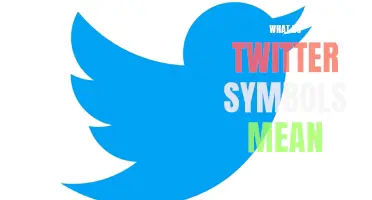
Shamrocks, with their vibrant green color and intricate shape, have become synonymous with Ireland and St. Patrick's Day. But did you know that these humble clover plants hold a deeper symbolism that extends beyond luck and festive celebrations? The shamrock symbol represents unity, faith, and the interconnectedness of all things in the natural world. Join me as we unravel the fascinating meaning behind this iconic emblem and discover why it continues to captivate our imagination.
What You'll Learn
- What is the origin of the shamrock symbol in Irish culture and what does it represent?
- How has the meaning of the shamrock symbol evolved over time?
- Are there any specific superstitions or beliefs associated with the shamrock symbol?
- In what other cultures or contexts is the shamrock symbol used and what does it symbolize in those contexts?
- Are there any variations or alternative interpretations of the shamrock symbol?

What is the origin of the shamrock symbol in Irish culture and what does it represent?
The shamrock symbol is deeply rooted in Irish culture and is often associated with St. Patrick's Day. This simple three-leafed plant has become an icon of Ireland and is widely recognized as a representation of Irish pride. But what is the origin of the shamrock symbol and what does it truly represent?
The shamrock symbol has its origins in ancient Irish folklore and mythology. It is believed to have been used by the druids, the religious leaders of pre-Christian Ireland, as a sacred plant. The word "shamrock" itself comes from the Irish word "seamrog," which means "young clover." The plant itself is a type of clover with three leaves instead of the usual four.
One of the legends surrounding the shamrock is that St. Patrick, the patron saint of Ireland, used it to explain the concept of the Holy Trinity to the pagan Irish. The Holy Trinity represents the Christian belief in one God expressed in three divine persons: the Father, the Son, and the Holy Spirit. According to the legend, St. Patrick used the three leaves of the shamrock to illustrate this concept, with each leaf representing one aspect of the Trinity.
This explanation of the Holy Trinity is just one interpretation of the shamrock's symbolism, as it has different meanings to different people. For some, the three leaves of the shamrock represent faith, hope, and love – the three theological virtues in Christianity. For others, it symbolizes the past, the present, and the future, or the three natural elements: earth, water, and sky.
Over time, the shamrock became a symbol of Irish pride and identity. It is often worn on St. Patrick's Day, which is celebrated on March 17th, as a way to show solidarity with Irish culture and heritage. The association of the shamrock with St. Patrick's Day can be traced back to the 18th century, when the holiday became an official feast day in the Catholic Church. St. Patrick is said to have used the shamrock to explain concepts of Christianity to the Irish people, and thus the shamrock became intertwined with the holiday.
In modern times, the shamrock symbol has become a popular motif in Irish art, jewelry, and clothing. It is widely recognized as a symbol of luck and is often used as a decorative element during St. Patrick's Day celebrations. The symbol has also been adopted by various Irish organizations and sports teams as a representation of Irish identity and pride.
In conclusion, the shamrock symbol has a deep and rich history in Irish culture. It is believed to have been used by the druids as a sacred plant and later became associated with St. Patrick as a means of explaining the Holy Trinity. Today, the shamrock is a symbol of Irish pride and is widely recognized as a representation of Irish identity. Whether it represents the Holy Trinity, the theological virtues, or simply luck, the shamrock continues to hold a special place in Irish culture and heritage.
Exploring the Hidden Meanings Behind TikTok Symbols
You may want to see also

How has the meaning of the shamrock symbol evolved over time?
The shamrock symbol is deeply rooted in Irish culture and is often associated with Ireland and St. Patrick's Day. But how has the meaning of the shamrock evolved over time?
The shamrock, also known as the clover, is a three-leafed plant that is believed to have been used as a symbol of Ireland since the time of St. Patrick, the patron saint of Ireland. According to legend, St. Patrick used the shamrock to explain the concept of the Holy Trinity to the Irish people, with each leaf representing the Father, Son, and Holy Spirit.
Throughout history, the shamrock has come to represent not only the Christian concept of the Holy Trinity but also Ireland itself. It has become a powerful symbol of Irish identity and is often used to signify Irish pride and heritage.
Over time, the shamrock symbol has also been associated with luck and good fortune. This belief likely stems from the fact that finding a four-leaf clover, a rare variation of the shamrock, is considered to be extremely lucky. The four-leaf clover is believed to bring good luck to those who find it and is often associated with wishes and dreams.
In modern times, the shamrock symbol has taken on additional meanings and interpretations. It has become a symbol of unity and inclusivity, representing the idea that we are all connected in some way. This interpretation has become particularly important in recent years, as the shamrock symbol has been used to promote acceptance and understanding among different cultures and communities.
The shamrock symbol has also been embraced by various sports teams, businesses, and organizations as a way to represent their Irish heritage or their connection to Ireland. It has become a recognizable emblem that is often associated with all things Irish.
In conclusion, the meaning of the shamrock symbol has evolved over time. It has gone from representing the Christian concept of the Holy Trinity to becoming a symbol of Irish identity and pride. It is also associated with luck and good fortune and has taken on additional meanings of unity and inclusivity. The shamrock continues to be a powerful and meaningful symbol that is deeply cherished by the Irish and those who celebrate Irish culture.
The Hidden Symbolism of the Black Panther: Unraveling its Meanings
You may want to see also

Are there any specific superstitions or beliefs associated with the shamrock symbol?
The shamrock symbol holds great significance in Irish culture and is often associated with various superstitions and beliefs. Known as a symbol of good luck, the shamrock is deeply rooted in Irish folklore and mythology. Here are some specific superstitions and beliefs associated with the shamrock symbol:
- Lucky Charm: The shamrock is believed to bring good luck and fortune to those who possess it. It is often worn as a lucky charm or carried in pockets or wallets for protection and to attract positive energy.
- Holy Trinity: The shamrock is closely associated with the Christian doctrine of the Holy Trinity, which represents God the Father, Son, and Holy Spirit. It is said that Saint Patrick, the patron saint of Ireland, used the shamrock to explain the concept of the Holy Trinity to the Irish people during his missionary work in the 5th century.
- Warding off Evil Spirits: It is believed that the shamrock has the power to ward off evil spirits and protect against bad luck. Many Irish people display the shamrock symbol in their homes, workplaces, and even on their clothing to keep negative energies at bay.
- Finding a Four-Leaf Clover: While the shamrock typically has three leaves, finding a four-leaf clover is considered extremely lucky. It is said that each leaf of a four-leaf clover symbolizes faith, hope, love, and luck. They are rare to find and are believed to possess magical powers and grant the finder good fortune.
- Planting Shamrocks: Planting shamrocks in the garden is believed to bring prosperity and good luck to the household. It is also thought to promote growth and fertility in the land. Many Irish people cultivate shamrocks in pots or gardens as a way of connecting with their cultural heritage and bringing blessings into their lives.
- Wedding Superstitions: In Irish weddings, it is customary for the bride to carry a small bunch of shamrocks in her bouquet to bring luck and blessings to the marriage. Additionally, shamrock-shaped decorations or motifs are often incorporated into wedding invitations, cakes, and other aspects of the wedding celebrations.
- Healing and Protection: In traditional Irish medicine, the shamrock is believed to have healing properties. It is used to treat various ailments, ward off illnesses, and protect against evil spirits. Some people even use shamrock-infused water or ointments for medicinal purposes.
Overall, the shamrock symbol holds a special place in the hearts of the Irish people. Its associations with luck, protection, and spiritual beliefs make it an important part of their cultural identity. Whether it is worn as a lucky charm or used in various ceremonies and traditions, the shamrock symbol continues to be cherished and respected as a symbol of hope, fortune, and Irish heritage.
The Fascinating Meanings Behind Hungarian Symbols and Icons
You may want to see also

In what other cultures or contexts is the shamrock symbol used and what does it symbolize in those contexts?
The shamrock is a well-known symbol that is closely associated with Ireland and the Irish culture. It is often seen as a symbol of luck and is prominently featured during St. Patrick's Day celebrations. However, the shamrock has also been used in other cultures and contexts, where it holds different meanings and symbolism.
One of the earliest uses of the shamrock symbol can be traced back to ancient Celtic culture. The Celts considered the shamrock to be a sacred plant that represented the arrival of spring and the rebirth of nature. They believed that wearing the shamrock would bring them good fortune and protect them from evil spirits.
In Christianity, the shamrock is often associated with the Holy Trinity - the Father, the Son, and the Holy Spirit. According to legend, St. Patrick, the patron saint of Ireland, used the shamrock to explain the concept of the Trinity to the pagan Irish people. Each leaf of the shamrock was said to represent one aspect of the Holy Trinity, and the whole plant symbolized the unity of the three.
In addition to its religious symbolism, the shamrock has also been used as a national symbol in various countries. For example, the shamrock is one of the national symbols of Montserrat, a British Overseas Territory in the Caribbean. The use of the shamrock in Montserrat is a nod to its Irish heritage, as many Irish people were transported to the island as indentured servants and slaves during the 17th century.
Similarly, the shamrock is also a symbol of the Newfoundland and Labrador province in Canada. This connection dates back to the early Irish settlers who arrived in Newfoundland in the 17th century. The shamrock is seen as a representation of the province's Irish roots and is often used in logos, flags, and emblems.
In some Native American cultures, the shamrock is considered a symbol of good luck and protection. It is believed that finding a clover with four leaves, known as a lucky clover, will bring the finder good fortune. The shamrock is also associated with the mystical and magical qualities of nature.
Overall, the shamrock is a symbol that transcends cultural boundaries and holds different meanings in various contexts. Whether it represents luck, the Holy Trinity, or a connection to Irish heritage, the shamrock remains an enduring symbol that is cherished and celebrated by many.
Understanding the Meaning of Mini Cooper Fuse Box Symbols
You may want to see also

Are there any variations or alternative interpretations of the shamrock symbol?
The shamrock, a three-leaf clover, is known as one of the most recognizable symbols of Ireland. It has been associated with the country for hundreds of years and is often worn on Saint Patrick's Day. However, while the traditional shamrock symbol consists of three leaves, there are variations and alternative interpretations of this iconic symbol.
Firstly, the most well-known variation of the shamrock symbol is the four-leaf clover. Unlike the three-leaf shamrock, the four-leaf clover is considered a symbol of good luck. It is believed that finding a four-leaf clover brings good fortune to the person who discovers it. Each leaf of the four-leaf clover represents a different aspect of luck: faith, hope, love, and luck itself. This variation of the shamrock is often used in jewelry and other accessories.
Another variation of the shamrock is the five-leaf clover. While not as commonly recognized as the four-leaf clover, the five-leaf clover is also associated with good luck. It is believed that finding a five-leaf clover brings even greater luck and prosperity compared to its four-leaf counterpart. The additional leaf is said to represent money or abundance.
In addition to these variations, there are alternative interpretations of the shamrock symbol. One such interpretation is the concept of the "shamrock spiral." This variation of the symbol consists of interconnected spirals that form the shape of a shamrock. The spirals represent the continuous cycle of life and symbolize unity and interconnectedness.
Another alternative interpretation of the shamrock symbol is the inclusion of additional leaves. Some variations feature shamrocks with more than three leaves, often representing a deeper connection to nature or a specific aspect of Irish culture. For example, a shamrock with seven leaves may symbolize the seven Celtic nations, while a shamrock with nine leaves may represent the nine virtues of ancient Irish society.
It is important to note that while these variations and alternative interpretations of the shamrock symbol exist, the traditional three-leaf clover remains the most widely recognized and iconic representation of Irish culture. It is deeply rooted in Irish folklore and continues to be a symbol of national pride.
In conclusion, while the three-leaf shamrock is the most well-known symbol associated with Ireland, there are variations and alternative interpretations of this iconic image. The four-leaf and five-leaf clovers symbolize good luck, while alternative interpretations such as the shamrock spiral and shamrocks with additional leaves offer different symbolic meanings. These variations and interpretations add depth and complexity to the symbolism of the shamrock, ensuring its enduring appeal and cultural significance.
The Symbolic Meanings and Origins of the Claddagh Symbol
You may want to see also
Frequently asked questions
The shamrock symbol is most commonly associated with Ireland and its rich history and culture. It is a three-leaf clover that is often used to represent the Holy Trinity in Christianity, with each leaf symbolizing the Father, Son, and Holy Spirit. The shamrock is also seen as a symbol of luck and is often associated with St. Patrick's Day.
While the shamrock symbol is strongly tied to Ireland, it can also be found in other cultures and traditions around the world. In some pagan beliefs, the three leaves of the shamrock represent the natural elements of earth, air, and water. Additionally, the shamrock is sometimes used as a symbol of luck and good fortune in various countries, not just Ireland.
A shamrock is a three-leaf clover, while a four-leaf clover is a rare variation with four leaves instead. While the shamrock is associated with Ireland and its cultural heritage, the four-leaf clover is often seen as a symbol of good luck and is believed to bring fortune to those who find it. The fourth leaf is believed to represent luck itself.
St. Patrick's Day is a cultural and religious holiday celebrated in Ireland and by Irish communities worldwide. The shamrock plays a significant role in this celebration as it is said that St. Patrick himself used the shamrock to explain the concept of the Holy Trinity to the Irish people. Therefore, wearing or displaying the shamrock on St. Patrick's Day is a way to honor both the saint and the country's cultural heritage.
There are many ways to incorporate the shamrock symbol into your everyday life if you are interested in Irish culture or simply enjoy the symbolism of the clover. You can wear jewelry or clothing with shamrock designs, decorate your home with shamrock-themed items, or even get a shamrock tattoo if you are looking for a more permanent display. Additionally, you can use the shamrock as a symbol of luck and incorporate it into your daily routines or rituals.







